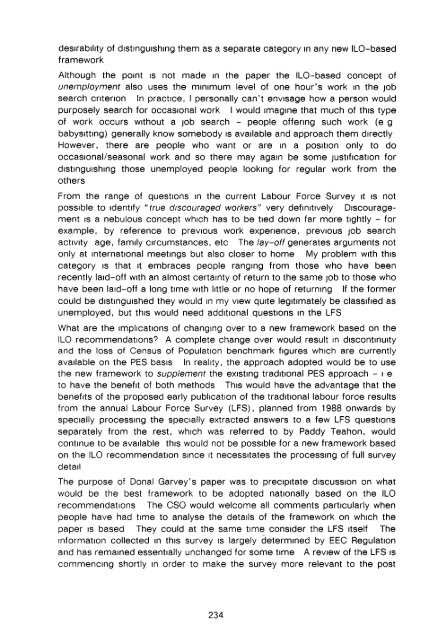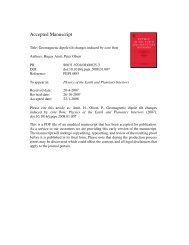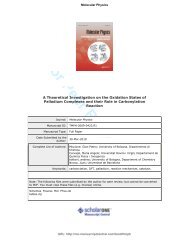WHAT IS THE BEST MEASURE OF EMPLOYMENT AND ... - TARA
WHAT IS THE BEST MEASURE OF EMPLOYMENT AND ... - TARA
WHAT IS THE BEST MEASURE OF EMPLOYMENT AND ... - TARA
You also want an ePaper? Increase the reach of your titles
YUMPU automatically turns print PDFs into web optimized ePapers that Google loves.
desirability of distinguishing them as a separate category in any new ILO-based<br />
framework<br />
Although the point is not made in the paper the ILO-based concept of<br />
unemployment also uses the minimum level of one hour's work in the job<br />
search criterion In practice, I personally can't envisage how a person would<br />
purposely search for occasional work I would imagine that much of this type<br />
of work occurs without a job search - people offering such work (e g<br />
babysitting) generally know somebody is available and approach them directly<br />
However, there are people who want or are in a position only to do<br />
occasional/seasonal work and so there may again be some justification for<br />
distinguishing those unemployed people looking for regular work from the<br />
others<br />
From the range of questions in the current Labour Force Survey it is not<br />
possible to identify "true discouraged workers'' very definitively Discouragement<br />
is a nebulous concept which has to be tied down far more tightly - for<br />
example, by reference to previous work experience, previous job search<br />
activity age, family circumstances, etc The lay-off generates arguments not<br />
only at international meetings but also closer to home My problem with this<br />
category is that it embraces people ranging from those who have been<br />
recently laid—off with an almost certainty of return to the same job to those who<br />
have been laid—off a long time with little or no hope of returning If the former<br />
could be distinguished they would in my view quite legitimately be classified as<br />
unemployed, but this would need additional questions in the LFS<br />
What are the implications of changing over to a new framework based on the<br />
ILO recommendations 9 A complete change over would result in discontinuity<br />
and the loss of Census of Population benchmark figures which are currently<br />
available on the PES basis In reality, the approach adopted would be to use<br />
the new framework to supplement the existing traditional PES approach - i e<br />
to have the benefit of both methods This would have the advantage that the<br />
benefits of the proposed early publication of the traditional labour force results<br />
from the annual Labour Force Survey (LFS), planned from 1988 onwards by<br />
specially processing the specially extracted answers to a few LFS questions<br />
separately from the rest, which was referred to by Paddy Teahon, would<br />
continue to be available this would not be possible for a new framework based<br />
on the ILO recommendation since it necessitates the processing of full survey<br />
detail<br />
The purpose of Donal Garvey's paper was to precipitate discussion on what<br />
would be the best framework to be adopted nationally based on the ILO<br />
recommendations The CSO would welcome all comments particularly when<br />
people have had time to analyse the details of the framework on which the<br />
paper is based They could at the same time consider the LFS itself The<br />
information collected in this survey is largely determined by EEC Regulation<br />
and has remained essentially unchanged for some time A review of the LFS is<br />
commencing shortly in order to make the survey more relevant to the post<br />
234
















